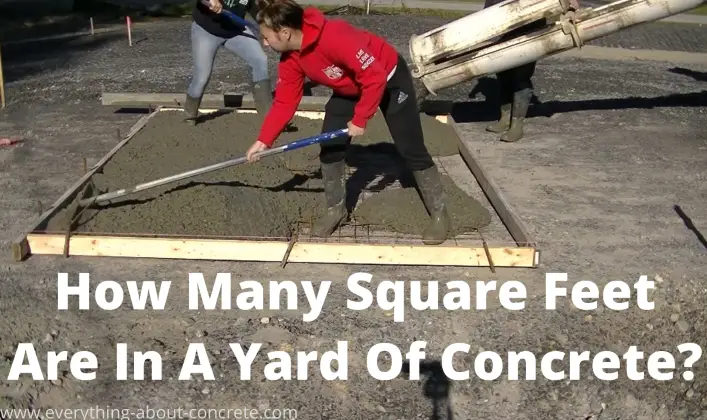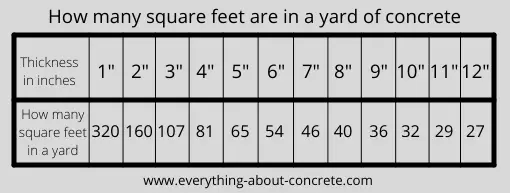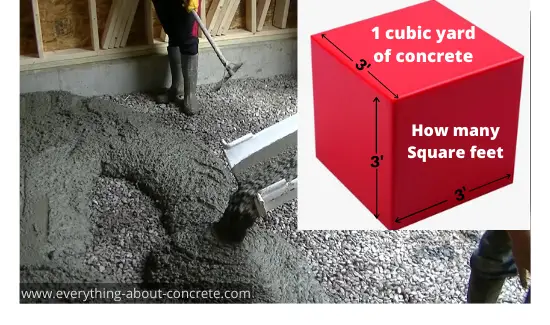The Ultimate Guide: Understanding the Conversion - Square Feet to Square Yards of Concrete
Updated April 8, 2024
by Mike Day

Welcome to the ultimate guide on understanding the conversion from square feet to square yards of concrete. Whether you're a homeowner embarking on a DIY project or a contractor working on a large-scale construction, knowing how to accurately convert these measurements is essential.
In this comprehensive guide, we will break down the conversion process step-by-step, providing you with the knowledge and tools needed to make precise calculations. We'll explain the difference between square feet and square yards, as well as why it's important to convert between the two.
Our expert tips and tricks will help you save time and money by avoiding common mistakes that can lead to unnecessary over- or under-ordering of concrete. Additionally, we'll provide you with real-life examples and practical scenarios to illustrate the conversion process in action.
By the end of this guide, you'll have a solid understanding of how to convert square feet to square yards of concrete accurately, ensuring your projects are completed efficiently and within budget. So, let's dive in and become conversion experts together!

IN ONE CUBIC YARD OF CONCRETE - there is 81 square feet at 4 inches thick.
The amount of square feet you'll get from a yard of concrete will be determined by how thick (depth) your concrete slab is.
A concrete slab that's 8' x 10' x 4" thick will take 1 yard of concrete.
How many square feet does a yard of concrete cover at different thicknesses?
The chart below shows you the exact amount of sq. ft. you'll get @ various depths.

Difference between square feet and square yards
Before we delve into the conversion process, let's first understand the difference between square feet and square yards. Both are commonly used to measure area, but they differ in terms of their unit of measurement.
A square foot (sq ft) is a unit of area that represents a square with sides measuring one foot each. It is often used in smaller-scale projects, such as residential construction or interior design. On the other hand, a square yard (sq yd) is a larger unit of area, equal to an area measuring one yard (three feet) on each side. Square yards are typically used in larger construction projects, such as commercial buildings or road construction.
The conversion between square feet and square yards is crucial because it allows for accurate estimation of materials needed for a project. Concrete, in particular, is commonly sold by the square yard, so understanding how to convert between the two measurements is essential for ordering the correct amount of concrete.
how many square feet in a yard of concrete 4 inches thick?
Most of the concrete floors and slabs I do are 4 inches thick. That's a normal thickness for most garages, patios, walkways, and shed slabs.
If the concrete slab is 4 inches thick then I'll get 81 square feet from 1 yard of concrete.
- A 10' x 10' concrete slab that's 4" thick will take 1.23 yards of concrete
- A 10' x 12' concrete slab that's 4" thick will take 1.48 yards of concrete
- A 20' x 20' concrete slab that's 4" thick will take 4.94 yards of concrete
- A 24' x 24' concrete slab that's 4" thick will take 7.11 yards of concrete

Why convert square feet to square yards for concrete projects
Converting square feet to square yards is especially important for concrete projects due to the way concrete is typically sold. In most cases, concrete is priced and sold by the square yard. Therefore, knowing the square yardage required for a project is crucial to ensure accurate ordering and avoid wastage or shortages.
By converting the square footage of a project into square yards, you can easily determine the amount of concrete needed. This prevents over-ordering, saving you money, and minimizes the risk of running out of concrete mid-project, which can cause delays and additional expenses.
Additionally, understanding the conversion from square feet to square yards allows for better communication with suppliers and contractors. When discussing your project requirements, being able to provide measurements in square yards will ensure everyone is on the same page, avoiding any confusion or misunderstandings.
Calculating square footage for concrete projects
Before we can convert square feet to square yards, we must first calculate the square footage of the area requiring concrete. This step is crucial as it forms the basis for the conversion process.
To calculate the square footage, measure the length and width of the area in feet. For example, if you're pouring a concrete patio that measures 15 feet in length and 10 feet in width, you would multiply these two measurements together: 15 ft x 10 ft = 150 sq ft.
It's important to note that irregularly shaped areas may require additional calculations. In such cases, you may need to break down the area into smaller, more manageable shapes (e.g., rectangles, triangles) and calculate their individual square footages before summing them up to get the total square footage.
Once you have determined the square footage of your concrete project, you can proceed to convert it to square yards for accurate ordering and estimation of materials.
Converting square feet to square yards
Now that we have the square footage of our concrete project, let's move on to the conversion from square feet to square yards. This conversion is relatively straightforward, requiring a simple mathematical calculation.
To convert square feet to square yards, divide the square footage by 9. Since there are 9 square feet in a square yard, this conversion factor allows us to determine the equivalent area in square yards.
Let's continue with the example of the 150 square foot concrete patio. To convert this area to square yards, we divide 150 sq ft by 9: 150 sq ft / 9 = 16.67 sq yd.
It's important to round up to the nearest whole number when dealing with measurements, so in this case, we would round up to 17 square yards. Therefore, for this particular project, you would need to order 17 square yards of concrete.
Remember, always round up to ensure you have enough concrete to complete your project. It's better to have a slight excess than to run out of concrete midway through the job.
Tools and resources for converting square feet to square yards
Converting square feet to square yards doesn't have to be a manual calculation. There are several tools and resources available that can simplify the process and save you time.
One popular option is to use an online conversion calculator. Many websites offer free conversion calculators that allow you to input the square footage and instantly obtain the equivalent in square yards. This eliminates the need for manual calculations and ensures accuracy.
Another useful tool is a construction calculator. These handheld devices are specifically designed for construction professionals and DIY enthusiasts. They can perform a wide range of calculations, including converting square feet to square yards. Construction calculators often have additional features such as unit conversions, material estimations, and built-in formulas for common construction tasks.
If you prefer a more traditional approach, you can also consult conversion tables or reference books specifically tailored to construction measurements. These resources provide conversion factors and formulas for various units of measurement, including square feet to square yards.
By utilizing these tools and resources, you can streamline the conversion process and minimize the risk of errors in your calculations. This ultimately leads to more accurate ordering and estimation of concrete, saving you time, money, and unnecessary headaches.
Common mistakes to avoid when converting square feet to square yards
Converting square feet to square yards is a crucial step in calculating the amount of concrete needed for a project. This conversion is important because concrete is usually sold by the cubic yard. Here are some common mistakes to avoid during this process:
- Forgetting to Convert Square Feet to Square Yards: Since there are 9 square feet in a square yard, failing to divide the total square footage by 9 can lead to purchasing either too much or too little concrete.
- Ignoring Thickness of the Slab: When calculating concrete yardage, the thickness of the concrete slab is as crucial as its area. The total cubic yards of concrete needed is a function of the slab’s thickness (in feet), width, and length (both in yards). Neglecting slab thickness can result in incorrect volume calculations.
- Mixing Units Without Conversion: Mixing units (e.g., feet with yards) without proper conversion can lead to calculation errors. Ensure all dimensions are in the same unit when calculating the volume of concrete needed.
- Rounding Errors: Prematurely rounding off measurements during the conversion process can lead to inaccuracies in the final calculation. It's better to keep as many decimal places as possible during calculation and round off only the final result if necessary.
- Not Accounting for Overages: It's advisable to add a contingency of about 5-10% to your total concrete volume to account for variations in ground leveling or slab thickness. Not including this buffer can result in not having enough concrete.
- Forgetting to Convert Dimensions to Yards for Volume Calculations: For volume calculations, all dimensions should be in yards (length, width, and depth/thickness) since concrete is sold by the cubic yard. Failing to convert feet to yards for all dimensions before multiplying can give you a volume measurement that is not accurate for ordering concrete.
- Overlooking the Shape of the Area: The calculation formula might differ slightly for circular or irregularly shaped areas compared to rectangular or square areas. Ensure you're using the right formula for the shape of your project.
- Neglecting Rebar or Mesh Displacement: When calculating concrete volume, some forget to account for the displacement caused by rebar or wire mesh. Although this might not significantly affect small projects, it can impact large ones.
- Assuming Uniform Depth Across the Site: If the site doesn’t have a uniform depth across its entire area, calculating as if it does can lead to inaccuracies. For areas with varying depths, calculate the volume for each section separately and then sum them up.
- Not Consulting with Suppliers: Concrete needs can vary based on project specifics, including the type of mix. Not consulting with your concrete supplier about your calculations and project requirements can lead to problems down the line, such as having the wrong mix or insufficient quantities.
Avoiding these common mistakes will help ensure that your concrete order is accurate, saving you time and money, and preventing delays in your project.
how much concrete do you need?
You can use the chart above to figure how many yards of concrete you need.
Since the chart tells you how many square feet are in 1 yard of concrete at a certain depth, you can use this formula to figure total yardage for your project.
At 4" thick the formula would look like this:
- Length X Width ÷ 81 = yardage (example 24' x 24' = 576 sq. ft. 576 ÷ 81 = 7.11 yards of concrete)
At 6" thick the formula would look like this:
- Length X Width ÷ 54 = yardage (example 24' x 24' = 576 sq. ft. 576 ÷ 54 = 10.66 yards of concrete)
The number you divide by will be determined by the depth. Use the chart above to figure out which number that is for you based off the depth of your slab, patio, driveway, etc.
use this concrete calculator to see how many yards you need
The concrete calculator below will help you determine the correct concrete yardage for your project.
Just type in your Length, Width, and thickness. Use feet and inches if you're in the USA, (or meter & centimeter) if you use the metric system.














